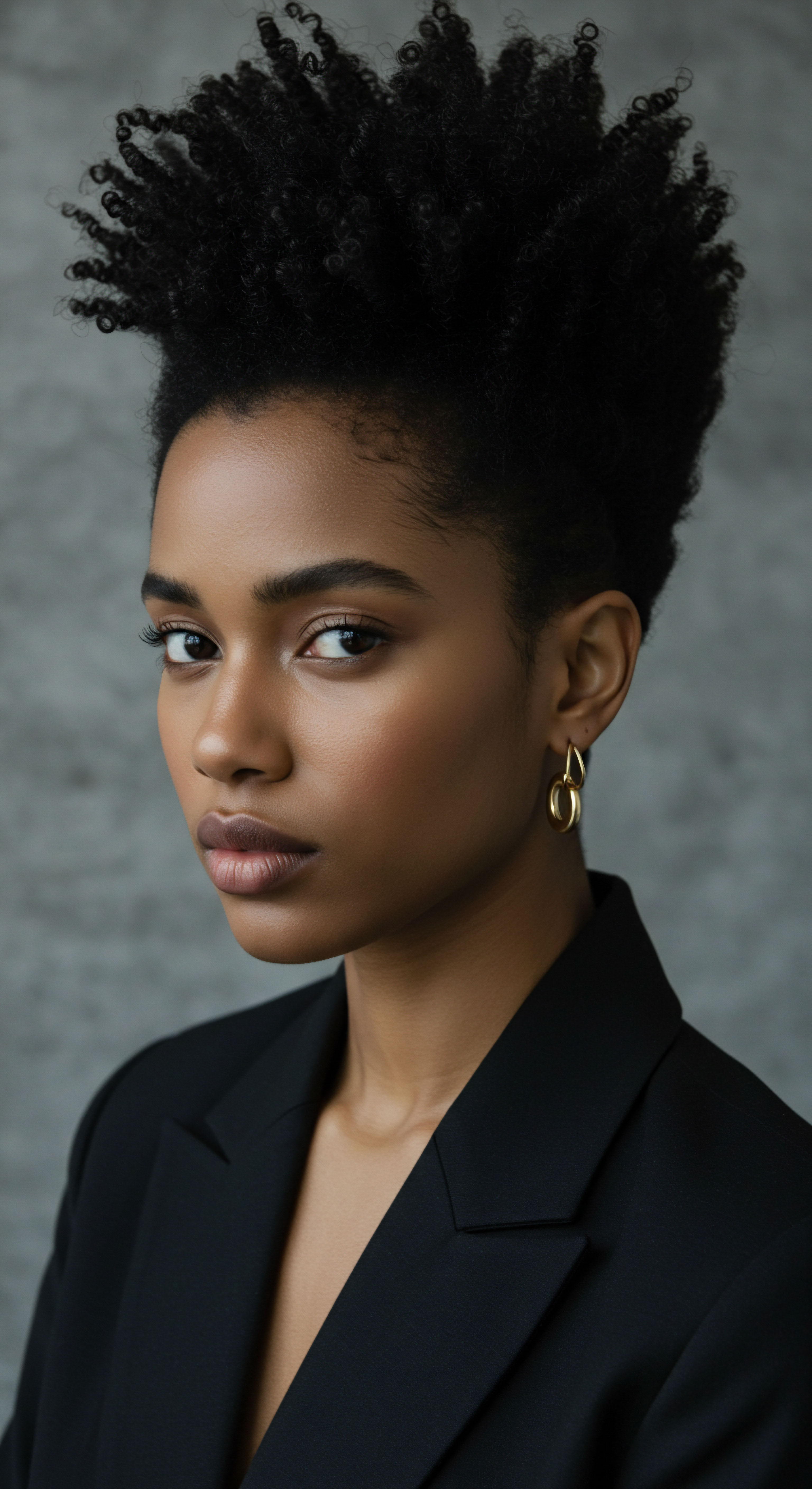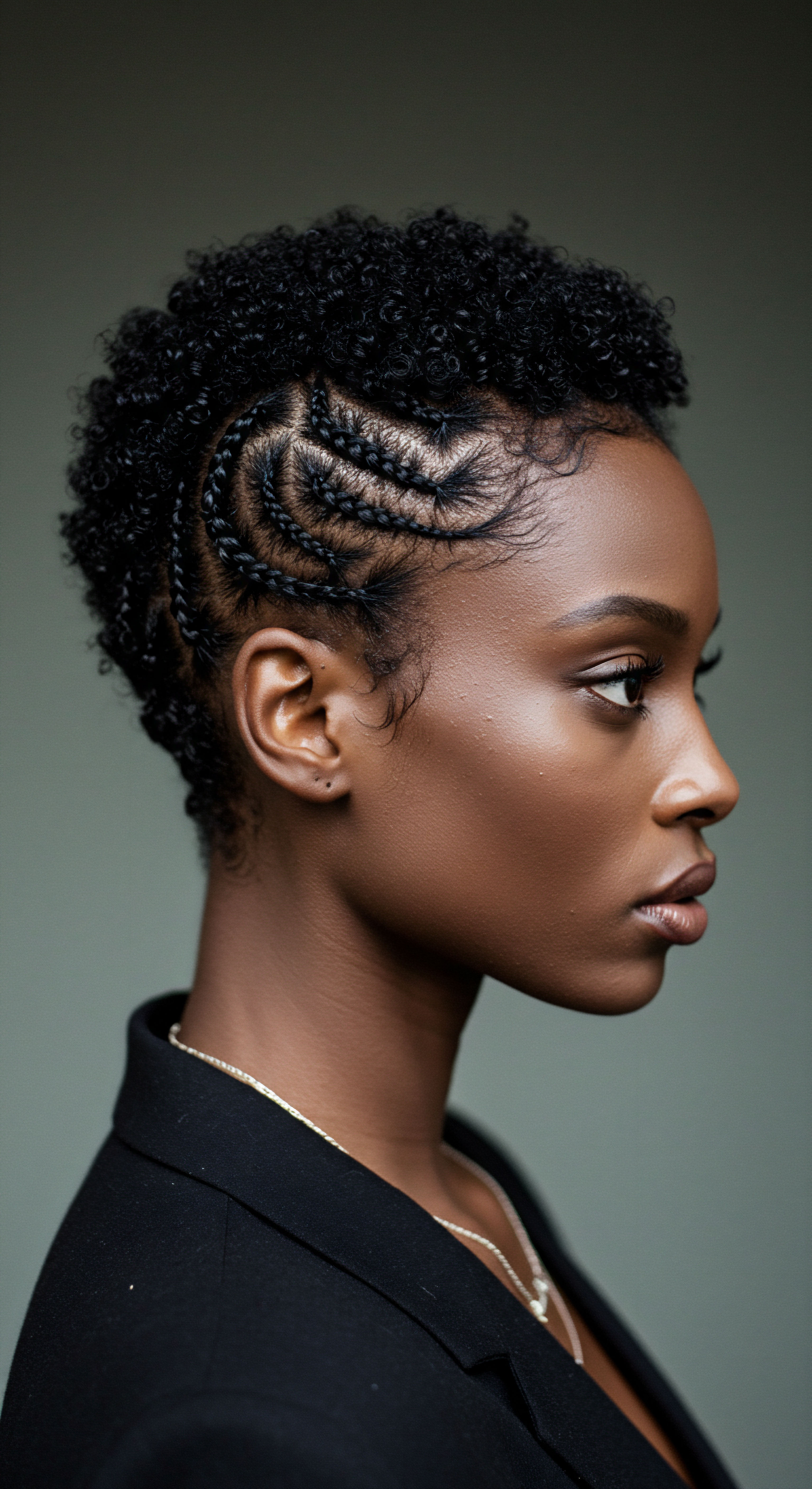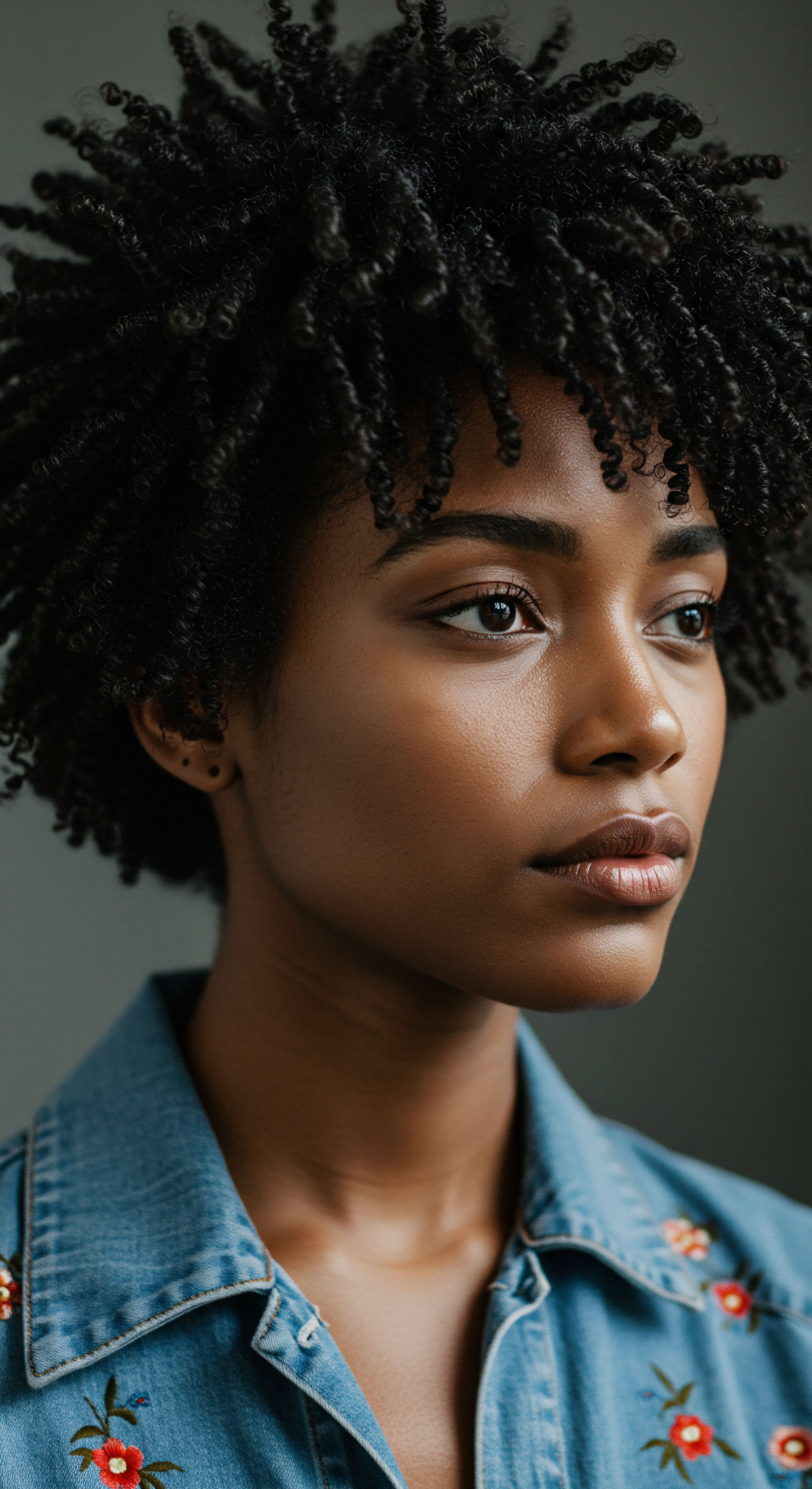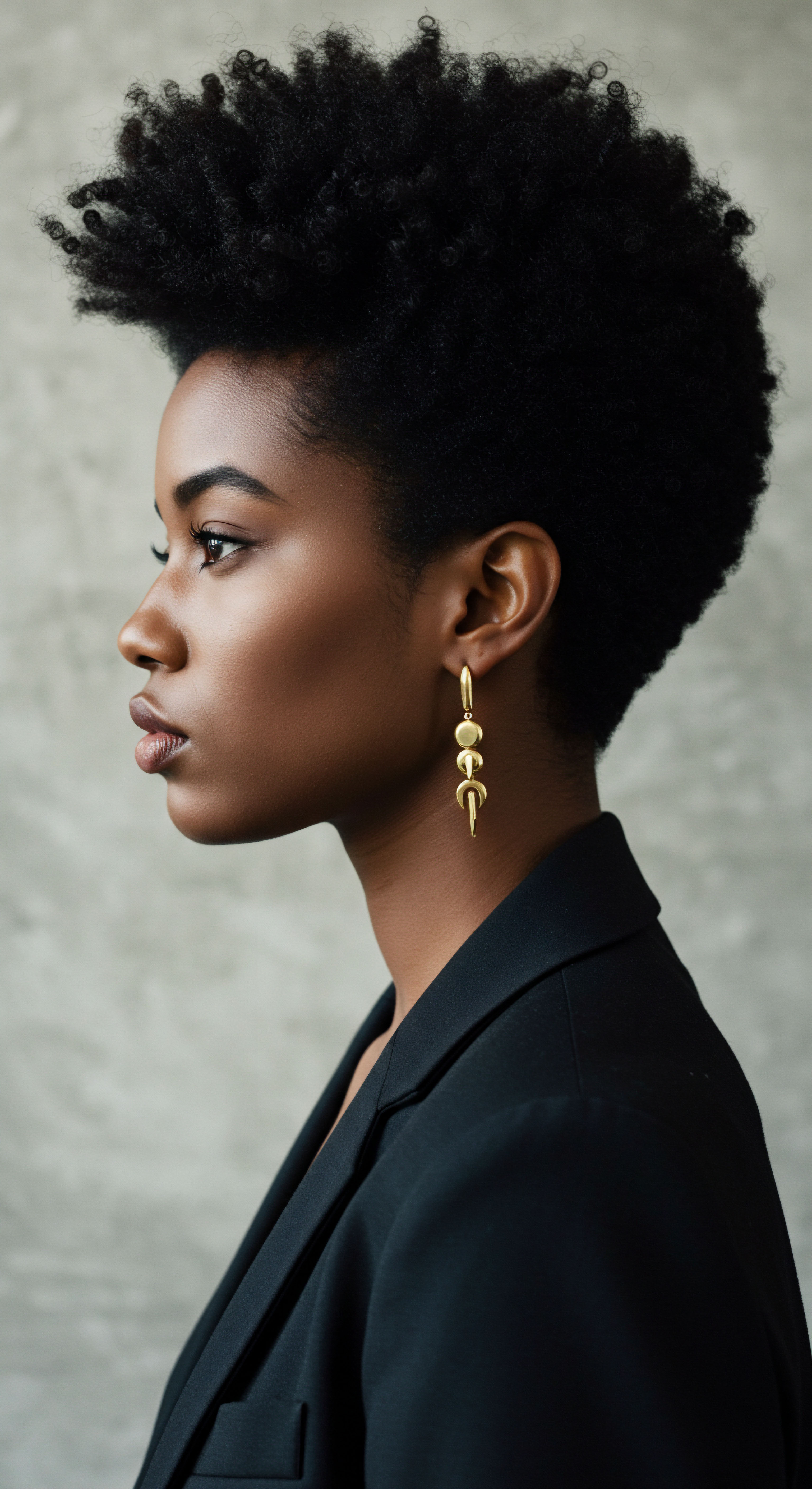
Roots
The silent stories held within our hair, particularly at its very foundation, the scalp, whisper of a time when our connection to the earth was unsevered. Before the advent of synthetic concoctions and the pervasive quest for immediate, often superficial, results, human communities around the globe looked to their immediate surroundings for solutions to bodily care. The tender landscape of our scalp, often a mirror reflecting internal balance or subtle imbalance, received its attention from nature’s bounty.
It is a quiet understanding that a vibrant crown springs from a well-tended root system, a concept deeply held within the practices of our forebears. This foundational wisdom, passed through generations, speaks to a holistic approach where the scalp was not merely a surface to be cleansed, but a living ecosystem, deserving of thoughtful, gentle care.
Our ancestral heritage, rich with botanical wisdom, offers profound insights into maintaining scalp health through methods that honored the body’s natural rhythms. These traditions often involved ingredients readily available from the natural world, applied with a reverence for their inherent properties. From the saponin-rich berries that lathered with a delicate touch to the mineral-laden clays that drew out impurities, each practice carried a lineage of observed efficacy. This exploration invites us to reconsider the elemental relationship between our hair’s beginnings and the earth that sustained those who came before us.

Understanding Scalp Ecosystems
The scalp, a unique extension of our skin, hosts a complex community of microorganisms, a delicate balance often overlooked in modern cleansing routines. This microbial landscape, much like the soil that nourishes a plant, influences the health and vitality of our hair strands. When this balance is disrupted, concerns such as dryness, irritation, or flaking can arise.
Ancestral cleansing methods, by their very nature, tended to be less aggressive, supporting this inherent equilibrium rather than stripping it away. They recognized the scalp as a responsive entity, a living canvas upon which the health of the hair was painted.
Consider the subtle interplay between oil production, cellular turnover, and the microbial residents. A healthy scalp maintains a harmonious environment where sebaceous glands produce just enough oil to protect and moisturize, and the shedding of dead skin cells occurs without visible flaking. Disrupting this delicate dance with harsh chemicals or excessive cleansing can lead to an overproduction of oil, a proliferation of undesirable microorganisms, or a heightened sensitivity. Ancestral practices often sought to restore this balance through methods that were in tune with the body’s innate healing capabilities.
Ancestral wisdom reveals the scalp as a living ecosystem, its vitality linked to natural rhythms and gentle care.

Botanical Gifts for Cleansing
Across continents, distinct botanical resources emerged as central figures in ancestral scalp care. These plant-derived cleansers provided a gentle alternative to modern detergents, often imparting additional conditioning and soothing properties. The efficacy of these traditional agents was not accidental; it stemmed from an intimate knowledge of their chemical composition and their interaction with the hair and scalp.
- Soapnuts ❉ These berries, from the Sapindus genus, contain natural compounds called saponins. When mixed with water, saponins produce a mild lather, making soapnuts an effective yet gentle cleansing agent. Their use is well-documented in Ayurvedic traditions for hair and scalp care, often leaving hair soft and shiny. Research indicates that soapnut extract can effectively remove dirt, oil, and product residue without excessive drying or irritation, and they possess antimicrobial properties that aid in maintaining scalp health.
- Shikakai ❉ Known as the “fruit for hair” in India, Acacia concinna pods are rich in saponins and have been used for centuries to cleanse and condition hair. Unlike many contemporary shampoos, shikakai does not strip away natural oils, promoting a mild cleansing experience. Its detangling properties also aid in reducing breakage.
- African Plants ❉ Diverse African plants, such as those from the Lamiaceae family (e.g. Lavandula species) and Asteraceae family (e.g. Eclipta prostrata ), were traditionally employed for hair and scalp conditions. Many of these plants are applied topically as extracts or infusions to address issues like baldness, dandruff, and lice, reflecting a deep botanical pharmacopoeia.
These botanical agents offered more than just cleansing; they delivered a symphony of natural compounds—antioxidants, vitamins, and minerals—that nourished the scalp and hair follicles. Their inherent mildness meant that the scalp’s protective barrier remained intact, preventing the dryness and irritation that often accompany harsher cleansing routines. This thoughtful selection of ingredients highlights a profound understanding of plant chemistry long before laboratories could isolate individual compounds.

Ritual
To truly comprehend ancestral cleansing methods, we must move beyond a simple list of ingredients and consider the deliberate practices that transformed these elements into nurturing rituals. The daily or periodic acts of tending to one’s hair and scalp were often steeped in intention, becoming moments of connection—to self, to community, and to the wisdom of generations past. It was not a hurried task, but a mindful engagement with the body’s rhythms, a quiet act of devotion that extended beyond mere hygiene. This section guides us through the thoughtful application of these ancient methods, revealing the artistry and scientific understanding embedded within their simplicity.
The cleansing practices of our ancestors were often interwoven with broader concepts of wellbeing. They understood that external applications had internal reflections, and that the health of the scalp was inextricably linked to the overall vitality of the individual. This comprehensive perspective meant that cleansing was not an isolated event, but a part of a larger regimen that included dietary considerations, lifestyle choices, and even spiritual observances.

The Gentle Wash of Rice Water
One remarkable example of a widespread ancestral cleansing practice is the use of fermented rice water. This seemingly simple concoction, the starchy liquid left after soaking or boiling rice, has been a cornerstone of hair care for centuries, particularly among the Yao women of Huangluo Village in China. Their renowned long, lustrous hair, which retains its color well into old age, is attributed to their consistent practice of washing with fermented rice water prepared in clay pots with added herbs.
The benefits of fermented rice water extend beyond anecdotal observation. Scientific investigation has revealed its richness in vitamins, minerals, and antioxidants, including inositol and ferulic acid. These compounds contribute to enhanced hair elasticity, reduced surface friction, and frizz prevention. More profoundly, fermented rice water, especially from red rice, has shown antifungal properties that can inhibit the growth of Malassezia, a fungus frequently associated with dandruff.
This illustrates a sophisticated, albeit intuitive, understanding of scalp microbiology long before microscopes revealed these tiny inhabitants. The slight acidity of fermented rice water also helps to balance the scalp’s pH, preserving its natural oils.

Clay and Earth Cleansing
From the mineral-rich soils of the Atlas Mountains to the ancient practices of indigenous communities, various types of clay have served as potent cleansing agents for the scalp and hair. Bentonite clay, for example, often referred to by Native Americans as “the mud that heals,” possesses a negative charge, allowing it to draw out positively charged impurities such as toxins, excess sebum, and product buildup from the scalp and hair follicles. Rhassoul clay, a brown wash-off product favored by Moroccan women for centuries, is similarly rich in magnesium, potassium, silica, and calcium, and its saponin content allows it to cleanse gently without stripping natural oils.
Ancestral cleansing was a mindful ritual, using nature’s gifts like fermented rice water and mineral-rich clays for holistic scalp vitality.
The application of these clays often involved mixing them with water to form a paste, which was then massaged onto the scalp and hair. This process not only cleansed but also delivered vital minerals directly to the skin, promoting circulation and soothing irritation. The wisdom behind these practices lies in their recognition of the earth’s inherent ability to purify and restore balance, offering a profound detoxifying experience that supported the scalp’s natural functions.

Herbal Infusions and Decoctions
Beyond simple washes, ancestral communities crafted complex herbal infusions and decoctions, tailored to specific scalp concerns. These preparations often involved boiling or steeping a combination of leaves, roots, and flowers to extract their medicinal properties.
Consider the intricate herbal preparations used in Ayurvedic medicine, where ingredients like neem ( Azadirachta indica ), known for its antiseptic and anti-inflammatory properties, were combined with other botanicals to address dandruff and scalp infections. Similarly, traditional African practices utilized a wide array of plants, with leaves often being the most used part, for their topical effects on scalp dermis infections and hair conditions.
| Agent Soapnuts |
| Primary Mechanism Natural saponins |
| Key Scalp Benefits Gentle cleansing, antimicrobial, anti-dandruff |
| Agent Fermented Rice Water |
| Primary Mechanism Antioxidants, inositol, mild acidity |
| Key Scalp Benefits pH balance, frizz reduction, anti-dandruff (anti-fungal) |
| Agent Bentonite Clay |
| Primary Mechanism Negative charge, mineral content |
| Key Scalp Benefits Detoxification, impurity absorption, mineral delivery |
| Agent Shikakai |
| Primary Mechanism Natural saponins |
| Key Scalp Benefits Mild cleansing, conditioning, detangling |
| Agent These agents reflect ancestral knowledge of natural chemistry for scalp wellness. |
The meticulous selection and preparation of these herbal remedies underscore a deep scientific understanding of plant compounds, long before modern pharmacology. Each ingredient was chosen for its specific contribution to scalp health, whether it was to soothe inflammation, combat fungal growth, or simply provide a thorough yet gentle cleanse. The consistency of these rituals, often performed weekly or bi-weekly, allowed for sustained benefits, promoting a healthy scalp environment over time.

Relay
How do these echoes of ancient practices reverberate within our modern understanding of scalp biology and the intricate world beneath our hair? This section invites a deeper contemplation, where historical traditions meet contemporary scientific inquiry, revealing surprising convergences and offering fresh perspectives on what constitutes true scalp wellness. We delve into the subtle yet profound interplay of biology, culture, and environmental factors that shaped ancestral cleansing methods, and how their principles offer a counterpoint to some prevailing modern norms.
The wisdom of past generations, far from being mere folklore, often contained an empirical understanding of cause and effect, honed over centuries of observation. When we examine these methods through a scientific lens, we begin to appreciate the sophisticated mechanisms at play, and how they contributed to robust scalp health in environments very different from our own.

Scalp Microbiome and Ancestral Balance
The human scalp is home to a complex and dynamic community of microorganisms, including bacteria and fungi, collectively known as the scalp microbiome. A healthy scalp maintains a diverse and balanced microbial population, which contributes to skin barrier function and overall scalp health. Disruptions to this balance, often triggered by environmental factors, lifestyle choices, or harsh cleansing products, can lead to conditions such as dandruff, itching, and inflammation.
A study exploring microbial dynamics on the scalp found significant shifts in microbial composition between healthy individuals and those affected by dandruff. Specifically, there was an observed shift from a dominance of Actinomycetota in healthy scalps to an increased presence of Basidiomycota, including the genus Malassezia, in dandruff-affected scalps. This highlights the delicate nature of the scalp’s microbial ecosystem.
Ancestral cleansing methods, by their inherent gentleness and reliance on natural ingredients, likely supported a more stable and diverse scalp microbiome. Unlike many modern synthetic shampoos that can strip the scalp of its natural oils and beneficial microbes, traditional cleansers such as fermented rice water offered a different approach. As previously noted, fermented rice water has demonstrated antifungal properties, specifically inhibiting the growth of Malassezia, a primary contributor to dandruff.
This suggests that ancient practices, whether through direct antimicrobial action or by fostering a hospitable environment for beneficial microbes, actively contributed to a balanced scalp flora. The less frequent, yet more thorough and nourishing, cleansing rituals of past cultures might have allowed the scalp’s natural protective mechanisms and microbial communities to thrive undisturbed for longer periods.
Ancient cleansing methods, gentle and natural, fostered a diverse scalp microbiome, unlike modern products that can disrupt its delicate balance.

Cultural Contexts of Cleansing Frequency
The frequency of hair washing in ancestral societies differed markedly from contemporary norms. In many modern cultures, daily or every-other-day washing has become commonplace, often driven by marketing and the perception of cleanliness. However, historical and anthropological accounts suggest that ancestral communities, particularly those with textured hair, practiced less frequent cleansing.
For instance, the American Academy of Dermatology recommends that individuals with Black hair wash their hair once a week or every other week to maintain health and prevent brittleness from over-washing. This modern recommendation aligns remarkably with the historical practices of many African and diasporic communities, where cleansing rituals were often spaced out, focusing instead on protective styling, oiling, and scalp massage between washes. This allowed the scalp’s natural oils to condition the hair and maintain its protective barrier, reducing dryness and breakage.
In Traditional Chinese Medicine, hair care was viewed as an integral part of overall health, with emphasis on nourishing the body from within. While daily combing was encouraged to stimulate qi and blood flow to the scalp, periodic washing was performed in a proper way and place to prevent disease. This approach prioritizes balance and internal harmony over aggressive external cleansing. The cultural value placed on long, healthy hair as a symbol of vitality and longevity in these traditions further underscores a preference for practices that sustained, rather than stripped, the hair and scalp.

Is Daily Cleansing Truly Better?
The prevailing modern narrative often suggests that more frequent washing equates to better hygiene and healthier hair. Yet, research on washing frequency presents a more nuanced picture. A study examining the impact of shampoo wash frequency on scalp and hair conditions in Asian populations found that while overall satisfaction was achieved with washing 5-6 times per week, concerns related to “overcleaning” were unfounded in their objective and subjective measures.
However, it is crucial to consider the diversity of hair types and environmental factors. For textured hair, which tends to be drier due to its coil pattern, excessive washing can lead to dehydration and breakage.
| Scalp Condition Healthy Scalp |
| Dominant Bacterial Phylum Actinomycetota |
| Increased Fungal Presence — |
| Scalp Condition Dandruff-Affected Scalp |
| Dominant Bacterial Phylum Shift from Actinomycetota |
| Increased Fungal Presence Basidiomycota (e.g. Malassezia ), Ascomycota |
| Scalp Condition Microbial balance is central to scalp health. |
This contrast highlights a critical point ❉ ancestral methods were often adaptive and responsive to specific hair textures and environmental conditions. The less frequent washing of textured hair in ancestral communities was not a lack of hygiene, but a sophisticated understanding of how to maintain moisture and structural integrity. This approach, which allows natural oils to distribute and protect the hair, is now being reaffirmed by modern dermatological recommendations for specific hair types.

Reflection
The journey through ancestral cleansing methods for scalp health reveals more than just a collection of historical recipes; it unearths a profound philosophy of care. Our forebears, guided by an intimate knowledge of their environment and the subtle language of their bodies, cultivated practices that honored the natural rhythms of hair and scalp. These methods, often rooted in botanical wisdom and communal ritual, speak to a deep respect for equilibrium—a balance within the microbial landscape of the scalp, a harmony between cleansing frequency and hair’s intrinsic needs, and a connection between external care and internal vitality. As we stand at the crossroads of ancient wisdom and modern science, the gentle echoes of these traditions offer a compelling invitation to re-evaluate our approach to hair wellness, urging us toward a more thoughtful, less abrasive, and ultimately, more resonant path to radiant scalp health.

References
- Wellgreen. (2023). Does Soapnut Cause Hair Loss? Benefits of Soapnuts for Hair and Scalp Health.
- Wolska, A. et al. (2019). Triterpenoid Saponins from Washnut (Sapindus mukorossi Gaertn.)—A Source of Natural Surfactants and Other Active Components. Molecules.
- Lin, F. S. (2000). Medical knowledge and uses of hair in traditional China. Chung Yang Yen Chiu Yuan Li Shih Yu Yen Yen Chiu So Chi K’an /Bulletin of the Institute of History and Philology Academia Sinica, 71, 67-127.
- Singh, M. K. et al. (2023). WORLD JOURNAL OF PHARMACEUTICAL RESEARCH.
- Guo, S. et al. (2018). Data mining on varieties, therapeutic uses and medicinal characteristics of Traditional Chinese Medicine preparations for treating hair loss. Journal of Traditional Chinese Medicine.
- Li, H. Y. et al. (2014). Research on the kidney and hair loss based on ancient Chinese medical literature. Archives of Hellenic Medicine.
- Sharma, R. et al. (2023). Formulation and Evaluation of Fermented Rice Water Herbal Shampoo For Antihairfall Activity. International Journal of Pharmaceutical Research and Applications.
- Agri Articles. (2023). Fermented Rice Water ❉ A Natural Elixir for Beauty and Health.
- Mayway Herbs. (2024). Hair Loss ❉ How Chinese Medicine Can Help.
- Sharma, N. et al. (2022). USE OF RICE WATER (Oryza sativa) & HIBISCUS (Hibiscus rosa-sinensis) FOR HAIR NUTRITION AND HAIR GROWTH. Journal of Emerging Technologies and Innovative Research.
- Yinova Center. (2024). Hair Loss ❉ How Chinese Medicine Can Help.
- Medical News Today. (2024). Rice water for hair ❉ Benefits and how to use it.
- Sarvangi, S. et al. (2022). A Systematic Review ❉ Application of Rice Products for Hair Growth. Journal of Drugs in Dermatology.
- Owsley, D. W. & Berryman, H. E. (1975). The Crow Creek Massacre ❉ The Role of Sex in Native American Scalping Practices. Plains Anthropologist, 20(68), 105-119.
- Suhagia, B. N. & Rathod, I. S. (2011). Sapindus mukorossi (areetha) ❉ An overview. International Journal of Pharmaceutical Sciences Review and Research, 2(8), 1905-1913.
- Obscure Histories. (2024). Champi ❉ The ancient Indian practice.
- Powder, J. (2022). Healing Historical Trauma. Hopkins Bloomberg Public Health Magazine.
- Juicy Chemistry. (n.d.). Soap Nut or Soapberries.
- ICT News. (2014). Native History ❉ Scalping of 10 Abenaki Celebrated; Where Did it Begin?
- Singh, R. et al. (2017). Herbal cosmetics in ancient India. Pharmacognosy Reviews, 11(22), 168.
- Tiwari, R. et al. (2021). Development and Evaluation of Herbal Hair Serum ❉ A traditional way to Improve Hair Quality. The Open Dermatology Journal, 15(1).
- ScienceIndiamag. (2025). Indian Beginnings of the Shampoo.
- Hiltunen, J. (2011). Spiritual and religious aspects of torture and scalping among the Indian cultures in Eastern North America, from ancient to colonial times. Scripta Instituti Donneriani Aboensis, 23, 227-248.
- Redbudhaven. (n.d.). Natural Hair Mask with Amazing Benefits ❉ Bentonite Clay.
- Britannica. (n.d.). Scalping History & Archaeological Evidence.
- Kumar, R. et al. (2023). A Review on Hair Care Cosmetics and Indian Medicinal Plants for Hair. International Journal for Multidisciplinary Research.
- Velasco, M. V. R. et al. (2016). The Scenario of Clays and Clay Minerals Use in Cosmetics/Dermocosmetics. Cosmetics, 3(4), 34.
- Zengin, G. et al. (2024). Cosmetopoeia of African Plants in Hair Treatment and Care ❉ Topical Nutrition and the Antidiabetic Connection? MDPI.
- Agyare, C. et al. (2022). Cosmetopoeia of African Plants in Hair Treatment and Care ❉ Topical Nutrition and the Antidiabetic Connection? ResearchGate.
- Penkar, G. M. et al. (2023). An Overview on Indian Herbs in Hair Care Therapy. Research Journal of Pharmacognosy and Phytochemistry, 15(2), 161-166.
- Moosavi, M. (2017). Bentonite Clay as a Natural Remedy ❉ A Brief Review. Iranian Journal of Public Health, 46(9), 1176–1183.
- Redbudhaven. (2023). The Healing Power of Minerals ❉ A Historical Overview of Clay and Mud Masks.
- Zaid, A. N. et al. (2016). Ethnopharmacological survey of home remedies used for treatment of hair and scalp and their methods of preparation in the West Bank-Palestine. BMC Complementary and Alternative Medicine, 16(1), 1-13.
- AHS India. (2020). Rhassoul Clay ❉ Benefits and Uses for Hair & Skin.
- Khan, N. et al. (2024). Preparation and Formulation Of Herbal Antidandruff Shampoo. International Journal of New Research in Development, 9(3), 32-38.
- WebMD. (2024). How Often Should You Wash Your Hair?
- Cleveland Clinic Health Essentials. (2025). How Often Should You Wash Your Hair?
- Shin, H. et al. (2021). The Impact of Shampoo Wash Frequency on Scalp and Hair Conditions. Skin Appendage Disorders, 7(3), 183-193.
- Zhang, S. et al. (2025). Exploring Microbial Dynamics ❉ The Role of Commensals in Healthy and Dandruff-Affected Scalps. bioRxiv.
- Shin, H. et al. (2021). The Impact of Shampoo Wash Frequency on Scalp and Hair Conditions. Karger Publishers.
- Harvard Medical School. (2021). The Guts of Our Ancestors.
- TRI Princeton. (2024). Scrub-A-Dub Dub ❉ How Often Should You Wash Your Hair & Scalp?
- Higuera, R. et al. (2021). A Case Study for the Recovery of Authentic Microbial Ancient DNA from Soil Samples. Microorganisms, 9(8), 1636.
- Zulu, R. et al. (2020). Gut Microbiome Profiles Are Associated With Type 2 Diabetes in Urban Africans. Frontiers in Cellular and Infection Microbiology, 10, 563606.
- Gkalpakiotis, S. et al. (2022). A Potential Predictive Role of the Scalp Microbiome Profiling in Patients with Alopecia Areata ❉ Staphylococcus caprae, Corynebacterium, and Cutibacterium Species. Journal of Clinical Medicine, 11(8), 2270.